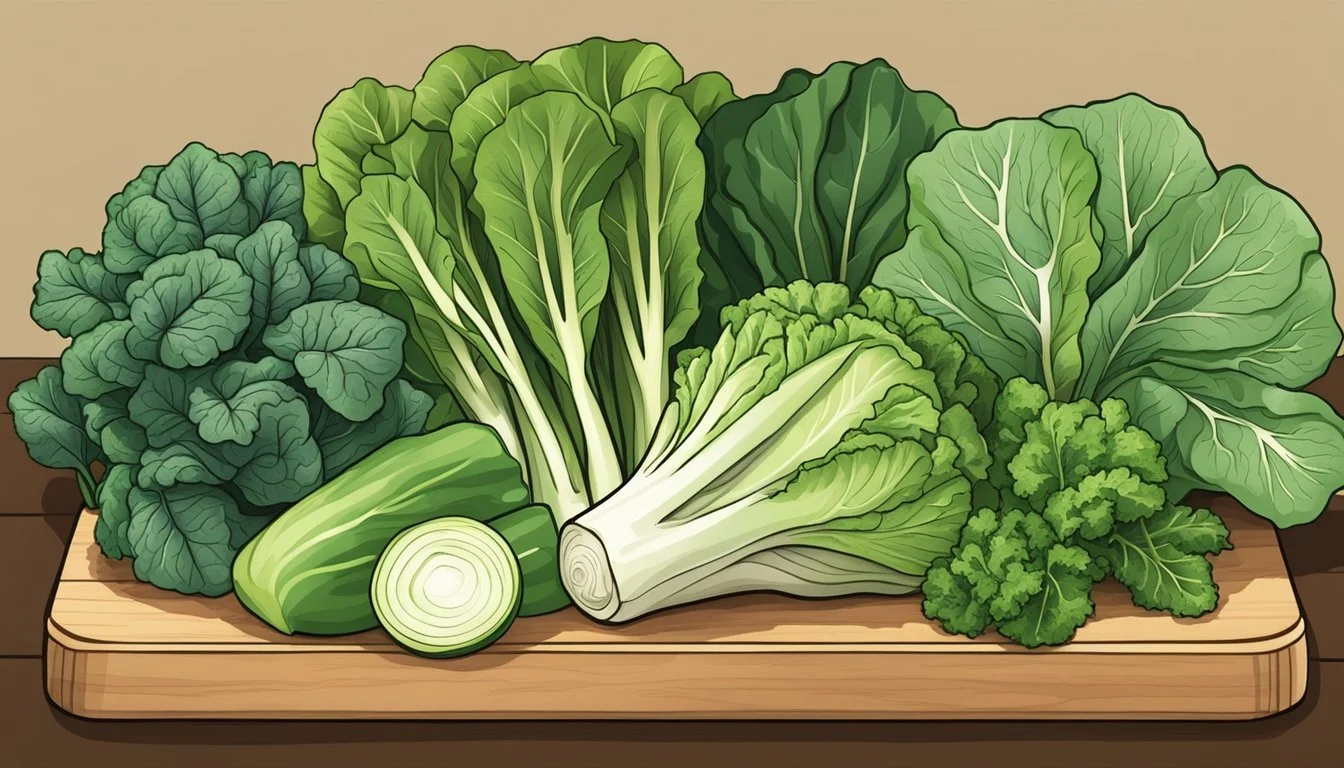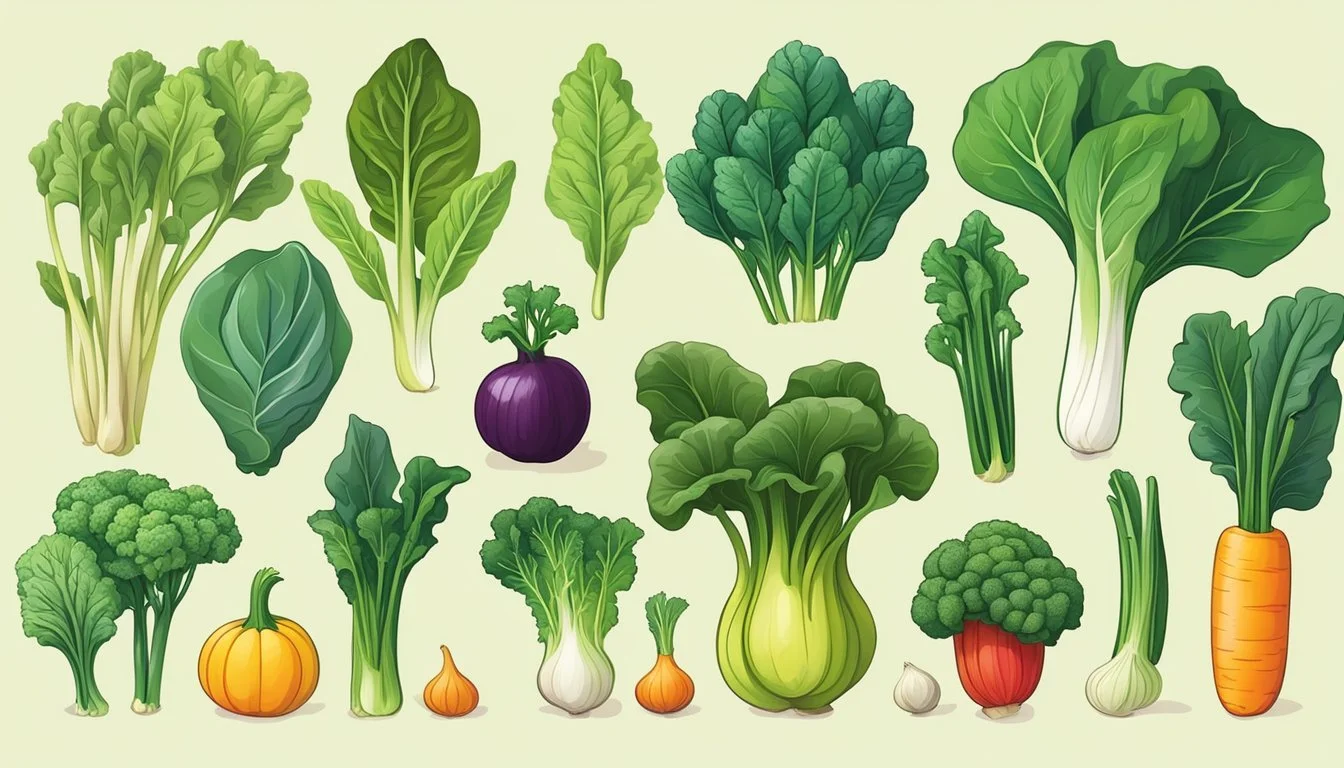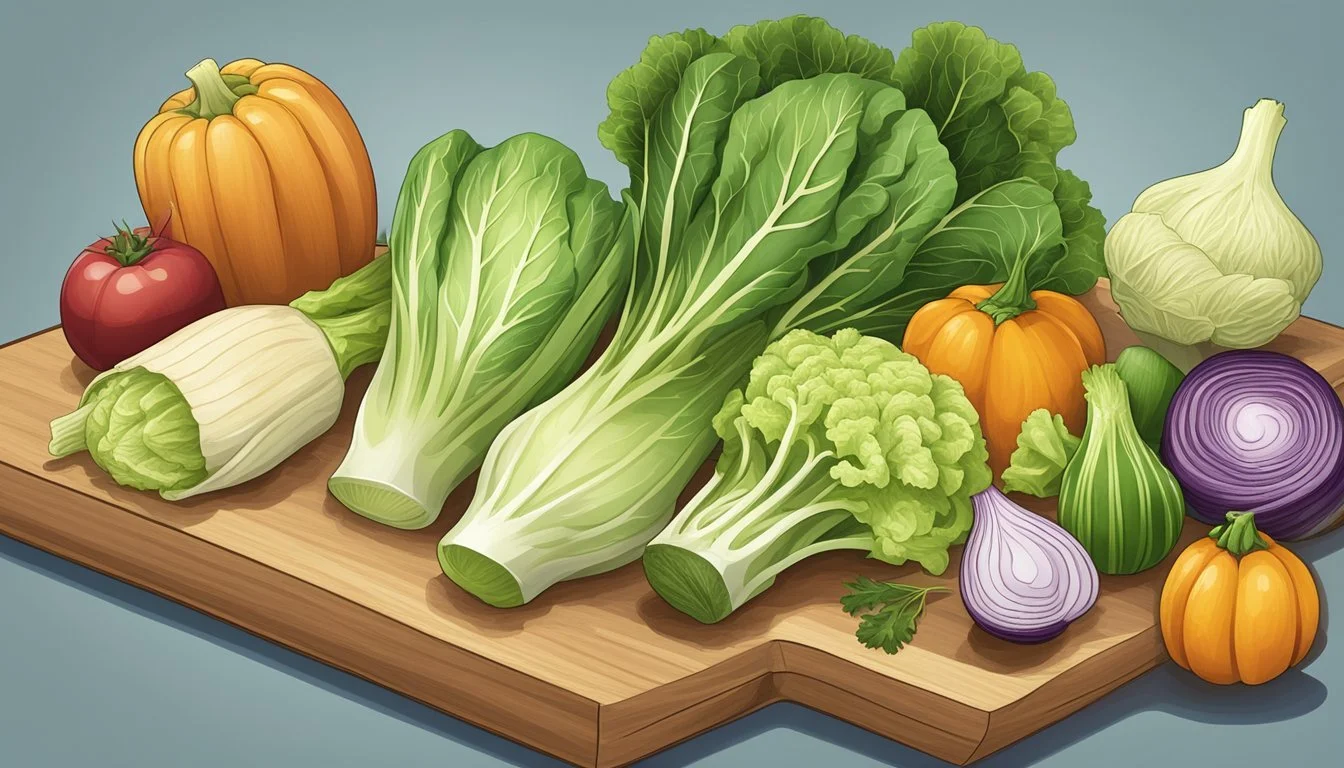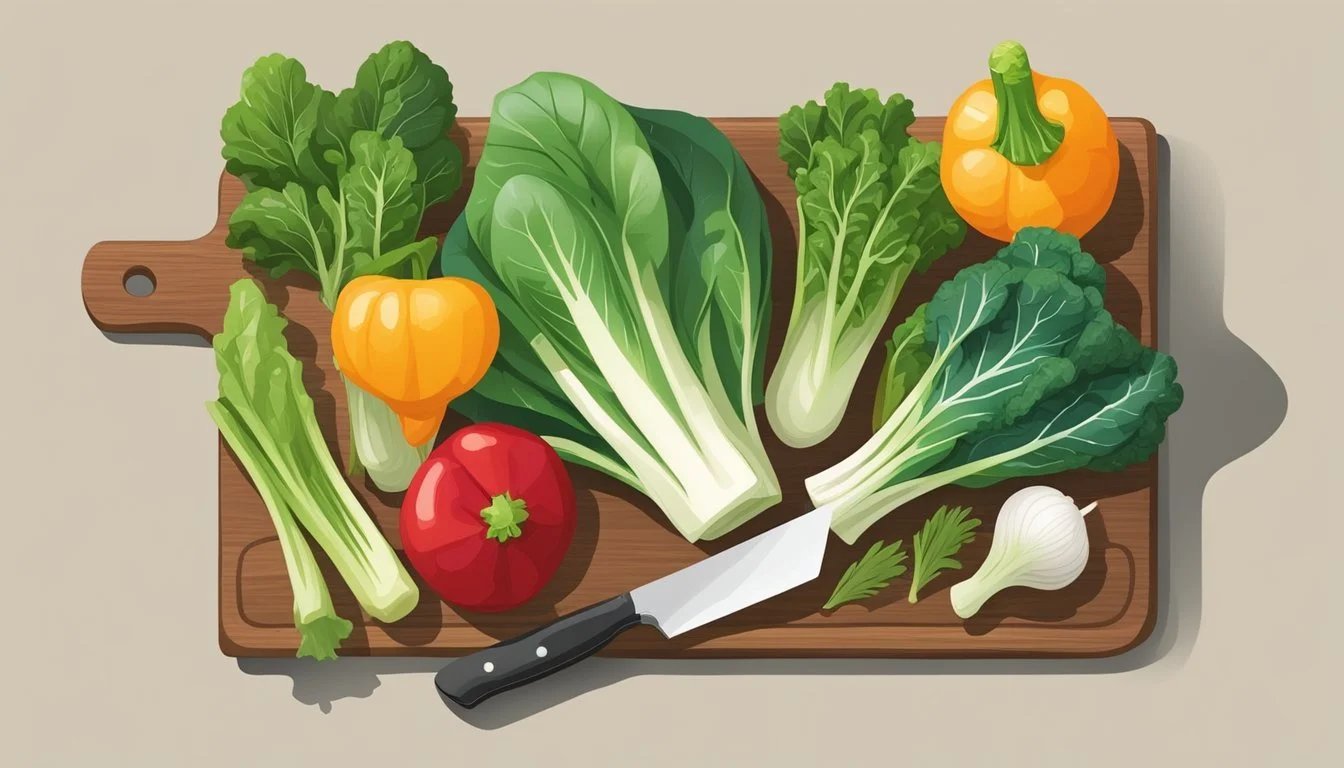Napa Cabbage Substitutes
Best Alternatives for Your Recipes
When trying to recreate a favorite recipe that calls for Napa cabbage, finding an effective substitute is crucial. Bok choy stands out as an excellent alternative due to its similar texture and flavor, making it a familiar substitute in both raw and cooked dishes. For those looking to diversify their ingredients, Taiwanese cabbage offers a subtle sweetness when cooked, closely mimicking the taste profile of Napa cabbage.
Spinach can also be a versatile option, particularly for its tender texture and mild taste which blends seamlessly into various recipes. For an extra splash of color and slightly different flavor, Green Swiss chard can be used, adding both vibrancy and an earthy hint to your meals. Each of these substitutes ensures that even without Napa cabbage, your culinary creations maintain their desired flavor and texture.
Understanding Napa Cabbage
Napa cabbage, also known as Chinese cabbage, is a staple in many Asian cuisines due to its versatile culinary applications and nutritious profile. This cabbage variety is known for its mild, sweet flavor and crunchy texture.
Origins and Characteristics
Napa cabbage has its roots in China and is a key ingredient in many traditional dishes. Known scientifically as Brassica rapa subsp. pekinensis, this cabbage features long, pale green leaves with white, thick stems.
The leaves are tender and less fibrous compared to other cabbage types. Its mild flavor, slightly sweet, makes it suitable for both raw and cooked dishes. Its texture is crisp when raw and becomes tender when cooked, adding to its versatility.
Culinary Uses
Napa cabbage is incredibly versatile in the kitchen. It is a primary ingredient in kimchi, a traditional Korean fermented dish. It’s also popular in salads and stir-fries due to its ability to absorb flavors well.
When used raw, it adds crunch to salads. Cooked, it softens and sweetens, making it ideal for soups and hot pots. Napa cabbage's mild taste complements various spices and sauces, making it a versatile option for different recipes.
Best Substitutes for Raw Napa Cabbage Uses
Napa cabbage is valued for its mild flavor and crunchy texture. When a substitute is needed, several vegetables can mimic its attributes beautifully.
In Salads
Curly Kale
Curly kale offers a similar crunch and can be eaten raw. Its slightly bitter flavor contrasts nicely with salad dressings, providing a robust texture.
Baby Kale
More tender than curly kale, baby kale can be a delicate addition to salads.
Lettuce
Varieties such as romaine and iceberg provide a refreshing crunch. While not as flavor-forward, lettuce can be easily found in stores.
Substitute Texture Flavor Curly Kale Crunchy Bitter Baby Kale Delicate Mild Lettuce Crunchy Mild
As a Wrap or Garnish
Swiss Chard
Swiss chard's large, sturdy leaves make it excellent for wraps. Its slightly earthy flavor complements a variety of fillings.
Endive
Endive leaves have a crunchy texture and slightly bitter taste, ideal for small wraps or garnishes.
Radicchio
With its vibrant color and firm texture, radicchio is perfect for a bold garnish. Its bitter flavor profiles well with rich or fatty dishes.
These alternatives offer a range of textures and flavors, ensuring a fitting substitute for various dishes and preferences.
Best Substitutes for Cooked Napa Cabbage Uses
When cooking with Napa cabbage, certain vegetables can serve as effective substitutes, each offering unique textures and flavors suited for different recipes. Below are options for replacing Napa cabbage in various dishes.
In Stir-Fries and Noodle Dishes
Bok Choy: Bok choy offers a similar crunchy texture and slightly sweet flavor. The stalks remain firm while cooking, making it an excellent substitute in stir-fries and noodle dishes. It also cooks quickly, just like Napa cabbage.
Green Cabbage: Green cabbage is another viable substitute, providing a bit more crunch and a stronger flavor. It holds up well to high heat and retains its texture better than Napa cabbage. Thinly slicing or shredding the green cabbage can help it integrate better into these dishes.
Choy Sum: Choy sum, with its tender stems and mild flavor, can mimic Napa cabbage's characteristics nicely. It’s also quick to cook, making it suitable for stir-fries and noodle dishes.
For Soups and Hot Pots
Savoy Cabbage: Savoy cabbage takes on a tender texture similar to cooked Napa cabbage but with a subtle nuttiness and crinkly leaves. It withstands longer cooking times, making it perfect for soups and hot pots.
Swiss Chard: Swiss chard, with its slightly sweet and earthy taste, works well in broths. The stems add a bit of crunch, and the leaves soften nicely, adding layers of texture and flavor to soups and hot pots.
Celery Cabbage: Known as Chinese cabbage, celery cabbage has a delicate flavor and tender leaves that fit well in hot pot dishes and brothy soups, maintaining a pleasant texture even after extended cooking.
In Dumplings and Fermented Dishes
Kale: For dumplings and fermented preparations like kimchi, kale offers a dense texture and slightly bitter taste. Its sturdiness means it doesn't break down easily, providing a firm bite.
Spinach: Spinach is a good alternative, especially for dumplings. Its tender leaves blend well with other ingredients, though it doesn’t hold up as well in fermented dishes due to its high water content.
Chinese Cabbage: Specifically for kimchi, Chinese cabbage or "celery cabbage" is the most authentic substitute, replicating the traditional flavor and texture almost perfectly. Its leaves absorb the fermenting spices excellently.
Alternative Vegetables with Similar Textures
When looking for alternatives to Napa cabbage, it's important to consider vegetables that offer similar textures. Some options provide that familiar crunch and juiciness, while others deliver a tender, leafy consistency.
Crunchy and Juicy Options
Bok Choy is a fantastic replacement due to its juicy stems and crisp leaves. The texture at the base of the leaves is especially similar to Napa cabbage, making it suitable for stir-fries and soups. The green parts need less cooking time, so keep an eye on them to avoid overcooking.
Red Cabbage offers a denser, crunchier option with a vibrant color. It holds up well in raw dishes like slaws and salads, and its sturdy leaves can be used in wraps or cooked dishes.
Kohlrabi is another option, known for its crisp and juicy texture. It can be sliced thin for salads or cooked in similar ways to cabbage. The bulbous stem is particularly crunchy, offering a great alternative in recipes where you want a bit of snap.
Tender and Leafy Options
Baby Kale is a soft, tender alternative when Napa cabbage is unavailable. Its delicate leaves can be eaten raw in salads or quickly wilted in dishes.
Green Swiss Chard adds a sweet, slightly earthy flavor. It has tender leaves and colorful stems, which bring vibrancy to any dish. It works well in both raw and cooked applications.
Romaine Lettuce offers a mix of crunch from the stems and tenderness from the leafy parts. It’s great for salads, wraps, and can even be grilled for a unique, slightly charred flavor. The lighter texture makes it a versatile option in various recipes.
Tatsoi has smooth, spoon-shaped leaves that are tender and mild. This Asian green is fantastic in salads and can also be lightly cooked. Its texture is close to spinach, providing a gentle bite.
Flavor Profiles and Considerations
When considering substitutes for napa cabbage, it is essential to understand the flavor profiles of possible alternatives and how to adjust recipes accordingly. This ensures that the dish retains its intended taste and texture.
Complementary Flavors for Napa Cabbage
Napa cabbage has a mild, slightly sweet flavor that blends well with a variety of ingredients.
Sweetness: The subtle sweetness of napa cabbage complements slightly salty or tangy elements such as soy sauce and vinegar.
Mild Flavor: Its mild nature pairs well with the nuttiness of sesame oil and the peppery flavor of garlic and ginger.
Crispy Texture: The delicate yet crispy texture makes it ideal for stir-fries, soups, and salads where a balance of textures is desired.
When choosing substitutes like Taiwanese cabbage or baby kale, matching these flavor dynamics is crucial.
Adjusting Recipes for Substitute Vegetables
Substituting napa cabbage with vegetables like Taiwanese cabbage, curly kale, or pointed cabbage requires minor adjustments.
Cooking Time: Some substitutes like kale may need longer cooking times to achieve a tender texture. Monitor the cooking process to maintain consistency.
Flavor Balance: Added bitterness in certain greens like kale can be mitigated by increasing sweeter elements, such as carrots or bell peppers.
Texture Considerations: Crispy alternatives such as pointed cabbage should be treated delicately to maintain their texture. Avoid overcooking to keep the dish appealing.
Seasoning Adjustments: Salt levels might need moderation since substitutes can vary in natural saltiness. Tasting throughout the cooking can help balance the dish effectively.
Health Benefits and Nutritional Information
Napa cabbage is known for its numerous health benefits. It is low in calories, with about 16-17 calories per 100 grams, making it a great choice for those watching their calorie intake.
Nutritional Profile per 100 grams:
Nutrient Amount Calories 16-17 Vitamin C High Vitamin K High Folate Moderate Antioxidants Yes
Health Benefits:
Vitamin C: Supports immune function and skin health.
Vitamin K: Essential for blood clotting and bone health.
Antioxidants: Includes lutein, carotenes, and zeaxanthin, which help combat oxidative stress.
Substitute Options:
1. Kale: Kale is another leafy green that can replace Napa cabbage. One cup of cooked kale has about 33 calories and is extremely rich in vitamins K (684%) and C (134%).
Nutrient Amount (per 1 cup cooked) Calories 33 Vitamin K 684% Vitamin C 134% Fiber 2.6 grams
2. Spinach: Spinach is also a leafy green known for its high nutritional content. It contains a host of vitamins and minerals beneficial for health.
Nutritional Profile per 100 grams:
Nutrient Amount Calories 23 Vitamin A High Vitamin C Moderate Folate High Iron Moderate
Including any of these leafy greens in your diet can contribute to overall health and provide a variety of essential nutrients.
Considerations for Specific Diets
When choosing substitutes for Napa cabbage, it's important to consider dietary restrictions and preferences. Different substitutes cater to various dietary needs, such as vegetarian, vegan, and low-carb options.
Vegetarian and Vegan Substitutes
For those following a vegetarian or vegan diet, several plant-based alternatives to Napa cabbage are available. Curly kale and baby kale are excellent options, offering similar nutritional benefits. Both can be used raw in salads or cooked in dishes like stir-fries and soups.
Choy sum is another great alternative. It has a mild, less "cabbagey" flavor and works well in various recipes. Lettuce, readily available, is also a convenient substitute, though it lacks the robustness and nutrient content of kale and choy sum.
Low-Carb and Keto Options
For low-carb or keto diets, some substitutes for Napa cabbage include bok choy and Taiwanese cabbage. Bok choy is versatile, with a similar texture and nutrient content, and can be used in both raw and cooked dishes. It’s a suitable option for hot pots and stir-fries without adding many carbs.
Endives are another useful option. They provide a slightly bitter taste and are low in carbohydrates, making them ideal for those watching their carb intake. Pointed cabbage can also be considered for its mild flavor and low carb content, and it suits numerous cooking applications.








